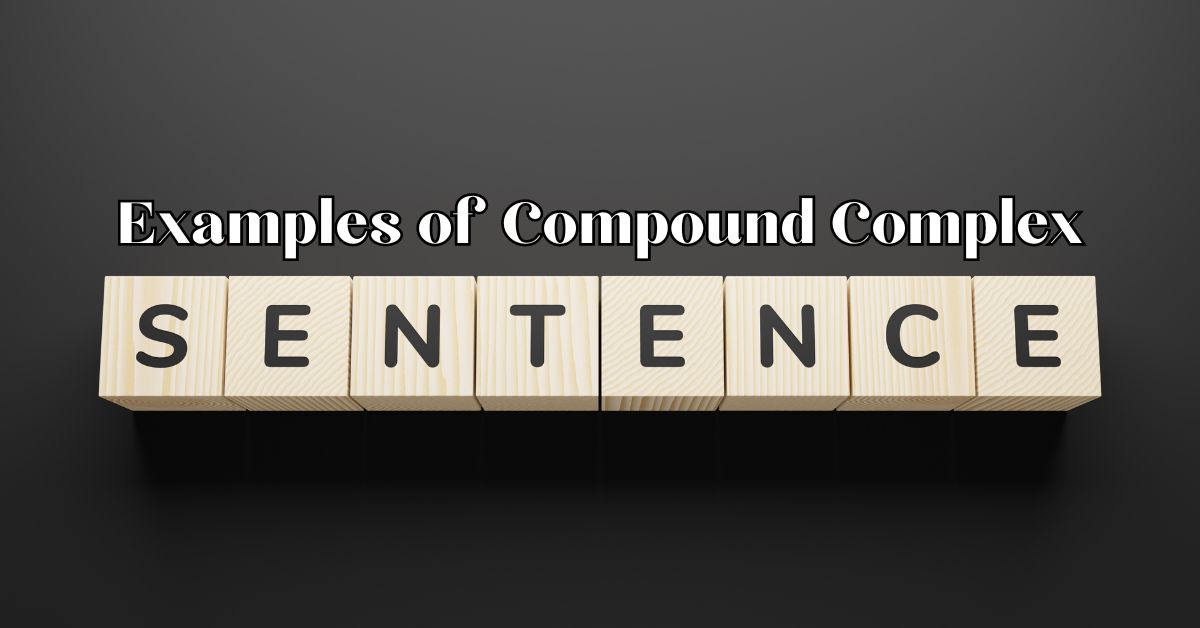Unlock the Power of Language by Examples of Compound Complex Sentences to Transform Your Writing. Discover the versatility and effectiveness of this sentence structure and learn how to promote your writing to new heights. In this blog, I tell you about the compound complex sentences and hoe to use them in sentences.
What are Compound Complex Sentences?
Compound complex sentences, a blend of compound and complex structures, consist of two or more independent clauses and at least one dependent clause. These sentences allow writers to express intricate relationships between ideas, making them essential for crafting cohesive and engaging narratives.
Why Use Compound Complex Sentences?
Compound complex sentences offer writers a powerful tool for conveying intricate ideas and relationships between concepts. By combining multiple independent and dependent clauses within a single sentence, writers can create a rich tapestry of information that engages readers and enhances the clarity and coherence of their writing. Here are several compelling reasons why incorporating compound complex sentences can elevate your writing:
- Expressing Complex Relationships: Compound complex sentences enable writers to articulate complex relationships between ideas, events, or characters within a single sentence. This allows for a more nuanced and sophisticated exploration of themes and concepts, fostering deeper engagement and understanding among readers.
- Enhancing Coherence: By integrating multiple clauses and subordinating conjunctions, compound complex sentences promote coherence and logical flow within a passage or paragraph. This cohesive structure guides readers through the interconnected ideas presented, ensuring a seamless reading experience.
- Conveying Depth and Detail: Compound complex sentences allow writers to delve into intricate details and provide comprehensive explanations or descriptions within a single sentence. This depth of information enhances the richness and complexity of the narrative, enriching the reader’s understanding and immersion in the text.
- Creating Variety and Interest: Incorporating compound complex sentences adds variety and interest to writing by breaking away from simple or repetitive sentence structures. This diversity in sentence construction maintains reader engagement and prevents monotony, contributing to a more dynamic and compelling narrative.
- Facilitating Persuasion and Argumentation: In persuasive or argumentative writing, compound-complex sentences offer a sophisticated means of presenting multiple points or supporting evidence cohesively and persuasively. This structured approach enhances the effectiveness of the writer’s argument, compelling readers to consider various perspectives and supporting details.
- Emphasizing Key Points: By strategically arranging clauses and subordinating conjunctions, writers can emphasize key points or ideas within a compound complex sentence. This allows for greater control over the rhythm and emphasis of the writing, ensuring that important information receives appropriate attention and emphasis.
- Reflecting Natural Speech Patterns: Compound complex sentences mirror the complexity and fluidity of natural speech patterns, making them well-suited for capturing authentic dialogue or conveying realistic thought processes. This authenticity enhances the readability and relatability of the writing, fostering a stronger connection between the writer and the reader.
Examples of compound complex sentences

The top 20 examples of compound complex sentences are given below;
- Literature: “Though he loved her deeply, he knew their relationship was doomed because of their differing ambitions and values.”
- Speeches: “While we face many challenges ahead, I remain optimistic about our ability to overcome them, fueled by our collective determination and resilience.”
- Academic Writing: “Despite extensive research on the topic, definitive conclusions remain elusive, prompting scholars to explore alternative methodologies and perspectives.”
- Everyday Conversation: “I wanted to join you for dinner, but I had to work late, so I’ll catch up with you next time.”
- Narrative Prose: “As the sun set, casting a warm glow over the horizon, she reminisced about her childhood adventures and dreamed of new ones to come.”
- Argumentative Essay: “While some argue for stricter regulations, others advocate for more lenient policies, citing the need to balance public safety with individual freedoms.”
- Historical Analysis: “Despite initial setbacks, the revolutionaries persevered, inspired by their unwavering commitment to liberty and justice for all.”
- Scientific Report: “As the experiment progressed, unexpected variables emerged, challenging the researchers to reconsider their hypotheses and methodologies.”
- Travelogue: “While exploring the bustling streets of Tokyo, I stumbled upon a quaint café where locals gathered to share stories and savor freshly brewed coffee.”
- Biographical Account: “Despite facing numerous obstacles throughout his life, he remained steadfast in his pursuit of excellence, fueled by his passion for innovation and discovery.”
- Political Commentary: “Amidst escalating tensions, diplomatic efforts continued behind the scenes, as world leaders sought common ground in pursuit of lasting peace.”
- Educational Lecture: “While traditional teaching methods have their merits, innovative approaches offer new opportunities for engagement and deeper learning experiences.”
- Legal Brief: “Despite compelling evidence presented by the defense, the prosecution remained steadfast in its pursuit of justice, advocating for accountability and restitution.”
- Environmental Documentary: “As temperatures rise and ecosystems falter, scientists warn of dire consequences unless immediate action is taken to mitigate the impact of climate change.”
- Family Memoir: “Though separated by distance, our bond remained unbreakable, strengthened by shared memories and the promise of reunions yet to come.”
- Psychological Study: “While genetics play a significant role in shaping personality traits, environmental factors also exert a profound influence on individual development and behavior.”
- Business Proposal: “Despite market fluctuations, our company remains committed to innovation and growth, leveraging strategic partnerships to expand our reach and impact.”
- Culinary Review: “As the chef skillfully combined flavors and textures, diners savored each bite, transported to culinary realms where tradition meets innovation.”
- Historical Biography: “Despite facing adversity at every turn, she emerged as a trailblazer in her field, breaking barriers and inspiring future generations with her resilience and tenacity.”
- Personal Reflection: “While navigating life’s twists and turns, I’ve learned to embrace uncertainty, finding solace in the beauty of unexpected journeys and newfound discoveries.”
These examples showcase the versatility and richness of compound complex sentences across various genres and contexts, illustrating their effectiveness in conveying complex ideas with depth and sophistication.
Also Read: Examples of Sentences with Adverbs and Adjectives
How to Construct Compound Complex Sentences
Constructing compound complex sentences requires a solid understanding of independent and dependent clauses, as well as effective punctuation usage. To create these sentences, follow these steps:
- Identify Main Ideas: Start by identifying the main ideas you wish to convey within the sentence. These ideas will serve as the independent clauses—the main building blocks of the compound complex sentence.
- Introduce Subordinate Clauses: Once you’ve identified the main ideas, introduce subordinate clauses that provide additional information, context, or detail related to the main ideas. Subordinate clauses are dependent clauses that cannot stand alone as complete sentences and are introduced by subordinating conjunctions such as “although,” “while,” “because,” “since,” “if,” etc.
- Use Punctuation Correctly: Proper punctuation is essential for structuring compound complex sentences. Use commas, semicolons, and conjunctions appropriately to connect independent and dependent clauses and indicate the relationships between ideas. Commas are used to separate independent clauses when they are joined by coordinating conjunctions (e.g., “and,” “but,” “or,” “yet,” “so”). Semicolons can be used to join closely related independent clauses without a coordinating conjunction. Subordinating conjunctions introduce dependent clauses and are followed by a comma when they appear at the beginning of a sentence.
- Ensure Clarity and Coherence: As you construct compound complex sentences, strive for clarity and coherence by ensuring that each clause contributes meaningfully to the overall structure and flow of the sentence. Avoid run-on sentences and ensure that the relationships between clauses are clear and logical.
- Maintain Parallelism: When constructing compound complex sentences with multiple clauses, strive for parallelism in structure and phrasing to enhance readability and coherence. Parallelism involves maintaining consistent grammatical structure and patterns within the sentence, particularly when listing items or expressing related ideas.
- Revise and Edit: After constructing compound complex sentences, take time to revise and edit your writing to ensure precision, clarity, and effectiveness. Pay attention to punctuation, sentence structure, and coherence, making revisions as needed to enhance the overall quality of your writing.
By following these steps and practicing regularly, you can effectively construct compound-complex sentences that convey complex ideas with clarity, coherence, and sophistication, enhancing the impact and readability of your writing.

